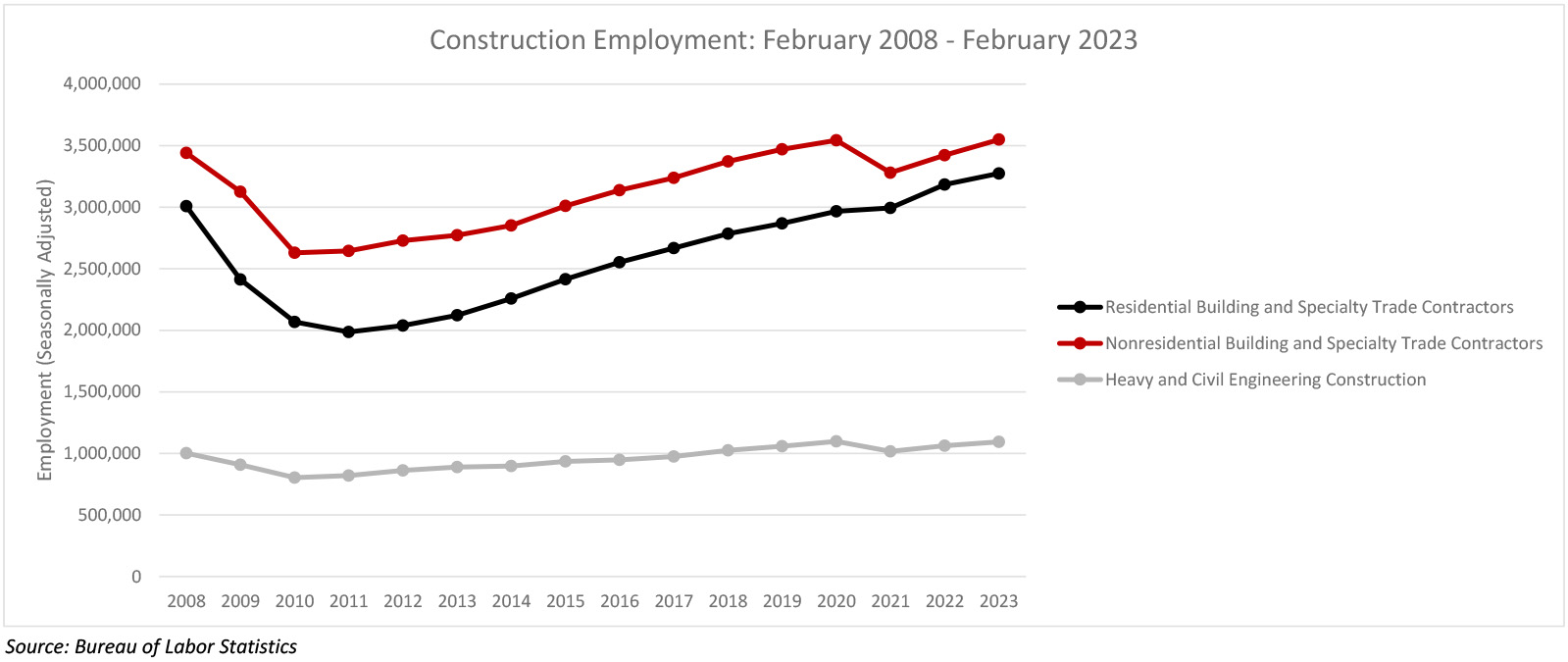
According to data released today by the US Bureau of Labor Statistics, the national construction industry added 24,000 jobs on net in February.
Key Takeaways
- The construction industry added 24,000 jobs on net in February.
- Nonresidential construction employment increased by 11,600 positions on net, with growth in all three subcategories.
- "Construction industry momentum may falter at some point in the future as project financing becomes increasingly expensive. That said, some contractors will continue to have significant workflow even in the instance of an economywide recession. That’s due to the arrival of megaprojects, including those emerging from infrastructure programs and investment in more manufacturing capacity in America."

Press Release from Associated Builders and Contractors, Inc (ABC)
Construction Adds 24,000 Jobs in February, Says ABC
WASHINGTON, March 10—The construction industry added 24,000 jobs on net in February, according to an Associated Builders and Contractors analysis of data released today by the U.S. Bureau of Labor Statistics. On a year-over-year basis, industry employment has risen by 249,000 jobs, an increase of 3.2%.
Nonresidential construction employment increased by 11,600 positions, with growth registered in all three subcategories. Heavy and civil engineering added 7,700 net new jobs, while nonresidential specialty trade added 2,200 positions. The number of nonresidential building jobs increased by 1,700.
The construction unemployment rate fell to 6.6% in February, down from 6.9% in January. Unemployment across all industries rose from 3.4% in January to 3.6% last month.
“Earlier this week, the Job Openings and Labor Turnover Survey indicated that the number of available, unfilled jobs in construction plummeted in January,” said ABC Chief Economist Anirban Basu. “The February jobs report makes it more likely that this data point is an aberration. Both residential and nonresidential contractors added jobs in February, which is consistent with ABC’s Construction Confidence Index indicating that many contractors continue to seek additional staffing.
“While industry momentum persists, the jobs report suggests that the Federal Reserve still has considerably more work to do to slow the economy,” said Basu. “Though average hourly earnings are not expanding as quickly as they had been, wages are still rising too rapidly on an annual basis to position the Federal Reserve to restore inflation to its 2% target. Accordingly, monetary policy is set to tighten more quickly going forward, with interest rates rising further and staying higher for longer.
“Construction industry momentum may falter at some point in the future as project financing becomes increasingly expensive,” said Basu. “That said, some contractors will continue to have significant workflow even in the instance of an economywide recession. That’s due to the arrival of megaprojects, including those emerging from infrastructure programs and investment in more manufacturing capacity in America.”
Press Release from Associated General Contractors of America (AGC)
Total Construction Employment Hits New Record High as Average Pay in the Sector Hits $33.57 an Hour, But Construction Officials Warn that Labor Shortages Will Make it Hard for Firms to Expand Further
Construction firms added 24,000 employees in February, as hefty pay raises for hourly workers enabled the industry to increase employment more steeply than other sectors, according to an analysis by the Associated General Contractors of America of new government data. Association officials said that while employment levels are now at record levels in the industry, future job gains will be hard given the lack of people who have been exposed to construction career opportunities.
“Average hourly earnings for craft and office workers in construction have consistently risen more sharply than across the private sector as a whole for several months,” said Ken Simonson, the association’s chief economist. “That has helped the industry add employees at a strong clip—but many more are still needed.”
Construction employment totaled a record 7,918,000, seasonally adjusted, in February, an increase of 249,000 or 3.2 percent from a year earlier. That growth rate exceeded the 2.9 percent rise in total nonfarm employment.
Nonresidential firms—comprising nonresidential building and specialty trade contractors along with heavy and civil engineering construction firms—added 11,600 employees in February and 158,700 employees or 3.5 percent over 12 months. Residential building and specialty trade contractors together added 12,400 employees for the month and 90,300 employees or 2.8 percent over the year.
Pay levels in the construction industry climbed in February at a faster pace than in the overall private sector for the sixth-straight month. Average hourly earnings for production and nonsupervisory workers in construction—mostly hourly craft workers—rose by 6.1 percent, from $31.63 in February 2022 to $33.57 last month. That increase topped the 5.3 percent rise in average pay for all private sector production workers. Workers in construction now earn an average of 18.1 percent more per hour than in the overall private sector.
Association officials said that while firms have had success recruiting workers by offering higher pay levels, the pool of qualified workers remains tight. They noted that relatively few new workers are exposed to construction while in school, which is a consequence of meager federal funding for career and technical education. They urged the Biden administration to boost funding for construction education programs.
“Construction firms are doing everything they can to bring in new workers to keep pace with demand,” said Stephen E. Sandherr, the association’s chief executive officer. “But it is hard to recruit workers who have never been exposed to the industry and don’t appreciate the amazing pay, benefits and satisfaction that comes with a career in construction.”













